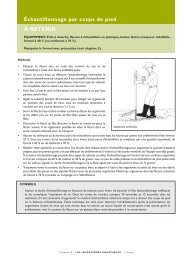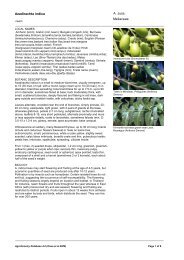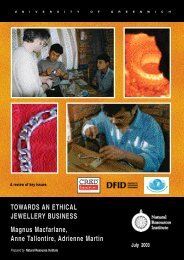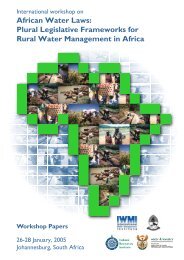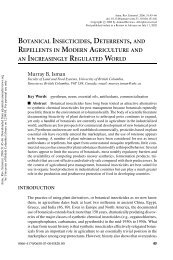Meteorological methods: temperature; humidity; rainfall; wind speed
Meteorological methods: temperature; humidity; rainfall; wind speed
Meteorological methods: temperature; humidity; rainfall; wind speed
You also want an ePaper? Increase the reach of your titles
YUMPU automatically turns print PDFs into web optimized ePapers that Google loves.
% Saturation of water with oxygen<br />
If the measured oxygen concentration at 17 ºC was 10.6 mg O2 l-1 , and using the table showing<br />
solubility of oxygen at 17 ºC to be 9.65 mg l-1 at 760 mm, then:<br />
% saturation = 10.6/9.65 x 100<br />
= 110% saturation of water with oxygen.<br />
pH<br />
Method<br />
• Check the calibration of the pH meter again before use – the calibration knob can get moved during<br />
transportation. Remove the electrode from its protective housing, rinse with distilled water and<br />
place in pH buffer to check calibration, rinse again.<br />
• Follow the same procedure for oxygen measurement (second bullet point) and note the<br />
<strong>temperature</strong> if not a compensating electrode.<br />
• For pH papers, take a sample of water in a jar and immerse the end of the paper for 30 s; remove<br />
paper and compare after a further 30-s delay with the colour comparator provided.<br />
CONDUCTIVITY<br />
Method<br />
• The electrodes are more robust and calibration is usually unnecessary in the field.<br />
• Follow the same procedure for oxygen measurement in water, and note the <strong>temperature</strong> if not a<br />
compensating electrode. Report as Siemens cm -1 (or mhos cm -1 ).<br />
• Rinse electrode and dry before storing.<br />
DEPTH<br />
Method<br />
• Measure depth with a pole in shallow water or with a rope, weighted at the end and knotted or<br />
marked at 0.5 m intervals, in deeper water. Suspend the rope from a boat and read the markers. If<br />
the water is moving, it may be difficult to suspend the rope vertically. Also, if waves are lapping the<br />
boat, take several readings and calculate the average.<br />
WATER TEMPERATURE<br />
Method<br />
• Water <strong>temperature</strong>s can be measured by glass thermometer, and most oxygen, pH and conductivity<br />
meters.<br />
OTHER CONSIDERATIONS<br />
In slow flowing rivers and lakes, pH, oxygen and (to a lesser extent) conductivity, vary quite widely with<br />
the time of day and biological activity. Standardize the times of measurement if possible and always record<br />
time and weather conditions.<br />
Always maintain the electrodes and meters as instructed by manufacturers – especially if they are stored<br />
for long periods.<br />
A GPS is useful to record positions of measurements.<br />
Chapter 5 E N V I R O N M E N TA L PA R A M E T E R S I. Grant



